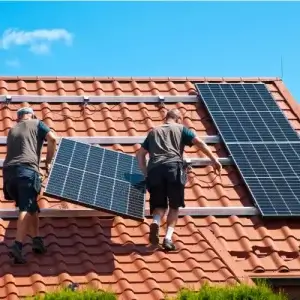Home / Compare Electricity &… / Compare solar feed-in ta…




Key takeaways
- If you own a solar PV system, a suitable solar feed-in tariff can help reduce your electricity bills by crediting your bill when you send excess electricity back to the grid.
- There are two types of solar feed-in tariffs that may be available to you – gross feed-in tariffs and net feed-in tariffs.
- The rates for solar feed-in tariffs vary between states and energy retailers, depending on where you live your tariff may be regulated, or you may be able to compare to find a deal that matches your energy needs.
Expert tips on choosing the right solar feed-in tariff for you
Our Head of Energy, Meredith O’Brien, has these top tips on solar feed-in tariffs and how to efficiently use solar so you can get the most out of your solar system.

Consider a solar battery
A solar battery allows you to store excess energy you’ve generated to use later when the sun’s not out. This means you’re less reliant on using energy from the grid and the costs associated from it.
Monitor the balance between energy usage and your solar feed-in tariff
If you have solar power but don’t have a battery, think about monitoring how much electricity you use at night. If your usage at night costs more than your solar feed-in tariff, you may want to consider a solar battery.
Check the energy efficiency of your appliances
Along with your solar feed-in tariff, you can also lower your energy bills by using energy-efficient appliances. These appliances may cost more upfront but have lower energy usage, helping you get the most out of your solar and reducing your dependency on the grid.
All about solar feed-in tariffs
What is a solar feed-in tariff?
A solar feed-in tariff is the amount of money you earn per kilowatt hour (kWh) of electricity from sending solar energy generated from your home panels back into the electricity grid. These rates vary depending on which state or territory you live in, your energy retailer (also known as energy provider) and your solar electricity plan.
How do solar feed-in tariffs work?
There are two types of solar feed-in tariffs you need to be aware of: gross feed-in tariffs and net feed-in tariffs.
Each tariff works slightly differently, but both pay you for the electricity your renewable energy system – such as photovoltaic (PV) solar panels or solar thermals – puts back into the grid.
Gross feed-in tariffs
If you’re on a gross feed-in tariff, your electricity retailer still credits you for the electricity your system generates and then puts back into the grid, but charges you separately for the electricity you use. These solar feed-in tariffs are being slowly phased out of the market as net feed-in tariffs are more commonly implemented.
Net feed-in tariffs
Net feed-in tariffs are used in New South Wales, South Australia, the ACT, Queensland, Victoria and Tasmania. Unlike gross feed-in tariffs, net feed-in tariffs only credit you for the solar energy you produce once your household or business has used the electricity it needs (i.e. your excess). If your system doesn’t generate enough to power your home or business, your retailer will still charge you for the additional electricity you use from the grid.
What’s the best solar feed-in tariff?
 It’s not easy to say which is the best solar feed-in tariff available because there is variance between retailers, states and your personal circumstances. You should compare your options regularly, as there might be a better deal than your current plan available to you.
It’s not easy to say which is the best solar feed-in tariff available because there is variance between retailers, states and your personal circumstances. You should compare your options regularly, as there might be a better deal than your current plan available to you.
Keep in mind that retailers may offer you the minimum government feed-in rate, but they can also offer you higher feed-in tariffs. However, it’s important to understand that the highest feed-in tariff rates may not necessarily be the best deal, as it may also come with higher electricity rates for any energy you use from the grid.
When you’re looking for the best solar energy plans for you or choosing a solar feed-in tariff that suits your needs, ask yourself:
- What is the solar feed-in tariff rate on offer?
- How much will I be charged for electricity usage?
- How much are the daily supply charges?
- Are there any other discounts or fees on offer?
What are the benefits of solar feed-in tariffs?
Depending on how much energy you send back to the grid, solar feed-in tariffs can have several benefits for both homeowners and small business customers, including:
- Helping the environment by reducing greenhouse gas emissions
- Reducing electricity bills
- Being credited for the extra energy you send back to the grid.
Introduction of solar two-way charging
What is solar two-way charging?
Two-way charging (or network charges for solar exports, export charges or ‘the sun tax’) is a plan for a two-way pricing system for exporting solar energy to the grid. The two-way tariff encourages customers to use their generated solar, rather than export it to the electricity grid during demand periods.
Instead, customers will be incentivised to store power in a battery and export solar power during peak demand periods which are generally from 4pm to 9pm.
As adoption of solar PV installations increases, so do solar exports. The issue is that the electricity network wasn’t meant to handle huge amounts of exported electricity during peak daytime export times. The two-way charging has been created as a way to potentially help alleviate this issue.
While two-way charging has been available on an opt-in basis for some states since 1 July 2024, customers will be moved onto this tariff on 1 July 2025.
Will I still get a solar feed-in tariff with two-way charging?
The Australian Energy Regulator (AER) will likely increase feed-in tariffs to encourage electricity exporting during peak periods, where electricity is most needed. During off-peak hours, there may be a lower solar feed-in tariff rate, and export charges may apply. The two-way charging is also attempting to nudge customers into storing their energy with a solar battery storage system so customers can become more self-sustainable.
These changes are set to hopefully lower overall energy bills and improve the efficiency of the electricity grid without flooding it with energy and causing instabilities.
Solar feed-in tariff rates by state
Each state and territory has different solar feed-in tariff rates and rules relating to these tariffs. Therefore, the credit you receive will be offset against your electricity bill and can vary based on where you live and whether competition is available. The solar feed-in tariff also changes yearly depending on wholesale electricity prices and other influences.
Note: The solar feed-in tariff prices referenced are based on figures from the 2024-25 financial year and may be subject to change.
New South Wales
Solar feed-in tariffs in NSW are measured by the kWh, but the rate paid varies between electricity retailers.1 The Independent Pricing and Regulatory Tribunal (IPART) in NSW sets a benchmark rate to guide retailers, but they’re still free to set their own prices.
The benchmark flat rate for the 2024-25 financial year is 4.9 to 6.3 cents per kWh.1
Victoria
Victorian solar feed-in tariffs fall under the state’s general renewable energy feed-in tariff scheme. The Essential Services Commission (VIC’s independent energy regulator) sets the rates.2 There are currently two tariffs available in Victoria: minimum single-rate and time-varying rates.
If you’re on the single-rate (also known as a flat rate) plan, retailers must offer at least the minimum solar feed-in tariff, which is 3.3 cents per kWh for the 2024-25 financial year.2 Retailers can also provide two options for time-varying tariffs, which pay different amounts depending on the time of day that electricity is sent to the grid.
| Option one for the 2024-2025 period | |||
| Time of day | Overnight (10pm-7am) | During the day (7am-3pm and 9-10pm on weeknights and 7am-10pm on weekends) | Early evening (between 3pm and 9pm on weekdays) |
| Cents per kWh | 11.3 | 4.4 | 4.4 |
| Source: Essential Services Commission. Minimum feed-in tariff. Accessed February 2025. | |||
| Option two for the 2024-2025 period | |||
| Time of day | Shoulder periods (9pm-10am and 2pm-4pm) | Off-peak periods (10am-2pm) | Peak periods (4pm-9pm) |
| Cents per kWh | 5.5 | 3.9 | 3.9 |
| Source: Essential Services Commission. Minimum feed-in tariff. Accessed February 2025. | |||
Queensland
There are two main solar feed-in tariffs in QLD, and which one you’re eligible for depends on where in the state you live.
Market feed-in tariffs
These are only available in South East QLD, where retailers can set and offer their own rates. Due to competition in this part of the state, it’s important to compare your options to look for the best solar feed-in tariff for your needs as they can vary significantly. For example, in the 2023-24 period, solar feed-in tariffs in South East QLD varied from 0.8 cents per kWh to 8.0 cents per kWh, with an average of 5.1 cents per kWh.3
Flat rate solar tariffs
For those in regional QLD, you may be able to access these tariffs through Origin Energy or Ergon Energy.4 This rate is set by the Queensland Competition Authority; for regional QLD, it’s 12.377 cents per kWh for the 2024-25 financial year.5
ACT
Feed-in tariffs in the ACT aren’t regulated, meaning retailers can set their own solar feed-in tariff rates.6 For this reason, it’s essential you compare your options, as rates can vary between retailers.
South Australia
Solar feed-in tariffs in SA differ from other states and vary based on when your PV solar system was installed. Everyone in the state with eligible systems can take advantage of retailer feed-in tariffs, where retailers set their own rates, and you can select one that best suits you.7
If your system was connected to the grid before 30 September 2011, you can apply for the distributor feed-in tariff. This feed-in tariff is set at 44 cents per kWh and will remain until 2028, unless you upgrade or amend your solar system or move house.
Northern Territory
In the NT, the energy market is dominated by government-owned retailer Jacana Energy. In 2020, Jacana stopped accepting customers to their premium feed-in tariff, and as of July 2022. Any customers who have been on the premium residential tariff of 29.21 cents per kWh for four years or more will be switched over to the current standard feed-in tariff of 9.33 cents per kWh, although the solar fit rate will double on 1 July 2025 to 18.66 cents per kWh.8 Any new customers are also placed on the standard tariff.
However, there are still other retailers available, so consider comparing across the different retailers to know your options.
Western Australia
If you’re in WA and export electricity to the grid, you may be eligible for the Distributed Energy Buyback Scheme (DEBS). Synergy customers can receive 10 cents per kWh for electricity sent to the grid between 3pm and 9pm, or 2 cents per kWh for all other times of the day.9 DEBS rates for Horizon customers have the same peak rate, but off-peak (9pm to 3pm) times have a slightly higher rate at 3 cents per kWh.
Tasmania
Feed-in tariffs in TAS are regulated by the Office of the Tasmanian Economic Regulator, who set a minimum rate that retailers must credit you for the electricity you send to the grid. For the 2024-25 period, this rate is 8.935 cents per kWh, which is a 17.8% decrease from the 2022-23 financial year.10
Important to know
Can I apply for a solar feed-in tariff before installing a solar PV?

No, you must install a solar PV system before you can apply for a solar feed-in tariff. Also, remember that you won’t automatically receive a feed-in tariff when your solar PV is installed. You’ll need to contact electricity retailers for their eligibility requirements and the offers available.
Your distributor must also update your meter configuration and your network tariff in Market Settlement and Transfer Solutions (MSATS) before you can start receiving the benefits of any solar feed-in tariff.
Where can I view which feed-in tariff I’m on?
The easiest way to check which feed-in tariff you’re on is to check your power bill or contact your electricity retailer. Because rates can vary between electricity retailers, it’s important to check your solar plan to see what feed-in tariff you’re on, especially in states or territories that offer competitive markets.
Are tariffs and solar rebates the same?
Tariffs and rebates aren’t the same thing when it comes to energy. A solar feed-in tariff is the rate you’re paid per kWh of electricity your solar system exports to the grid. A solar rebate, however, usually refers to a government initiative or incentive to help you pay for your solar installation.
There used to be solar feed-in tariff schemes to encourage the export of electricity to the grid, but as the amount of solar residential customers increases, these have begun to be phased out.
Will I always save money by using solar power?
In most cases, you can save money by using solar power, but there’s no guarantee. While solar power can potentially save you money, the exact figure will depend on a variety of factors. These include:
- Whether you’re on a gross or net feed-in tariff
- If you’re exporting electricity when it’s most needed (if you’re on a two-way charging tariff)
- What your solar system size is and what its export limits are
- How much exposure to the sun your rooftop solar system has throughout the day, as feed-in tariffs may also vary during the time of day
- The amount of electricity you use and when you use it (e.g. maximising your solar energy usage during the day and minimising your usage during evenings and nights).
The ideal plan to save money would have high feed-in tariffs and low usage rates for your electricity from the grid. However, how you use electricity in your plan and when you export to the grid will be one of the biggest factors in whether or not you save.
Meet our Head of Energy, Meredith O’Brien
As the Head of Energy at Compare the Market, Meredith O’Brien believes in educating Australian customers about the everchanging gas and electricity market so they can adjust their energy usage habits and get the most out of their energy plans.
Meredith has six years within the energy industry, following 15 years of experience in financial services and is currently studying a Master of Business Administration. Meredith is a dedicated customer advocate who is passionate about empowering Australians to find the right products to suit their needs by removing the confusion from comparing.
1 Independent Pricing and Regulatory Tribunal NSW. Solar feed-in tariffs in NSW. Published May 2024. Accessed February 2025.
2 Essential Services Commission. Minimum feed-in tariff. Accessed February 2025.
3 Queensland Competition Authority. Solar feed-in tariffs in south-east Queensland 2023-24. Published October 2024. Accessed February 2025.
4 Queensland Government. Solar feed-in tariff for regional Queensland. Updated August 2023. Accessed February 2025.
5 Queensland Competition Authority. Solar feed-in tariff for regional Queensland 2024-25. Published June 2024. Accessed February 2025.
6 ACT Government: Everyday climate choices. Solar feed-in tariff. Accessed February 2025.
7 Government of South Australia. Solar feed-in payments. Updated July 2024. Accessed February 2025.
8 Jacana Energy. Solar update: Changes to the Premium Solar feed-in tariff. Accessed February 2025.
9 The Government of Western Australia. Energy Buyback Schemes. Updated December 2024. Accessed February 2025.
10 Office of the Tasmanian Economic Regulator. Feed-in Tariffs. Accessed February 2025.

